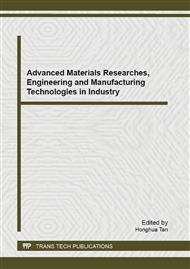p.328
p.333
p.337
p.341
p.346
p.352
p.356
p.363
p.367
Microstructure and Mechanical Properties of Friction Stir Welded Annealed Pure Copper Joints
Abstract:
As a novel technique for joining materials, friction stir welding (FSW) has significant advantages over the conventional welding methods and is widely applied for joining different materials including aluminum, magnesium and copper alloys. In this research, the mechanical and microstructural characteristics of friction stir welded annealed pure copper joints were investigated. The influence of the tool rotation speed, welding speed and applied load was studied. The friction stir welding (FSW) was conducted at welding speed ranged from 30 to 70 mm/ min, rotation speed ranged from 400 to 1200rpm and applied load ranged from 1000 to 1500 kg. After welding process, tensile and Vickers hardness tests were performed. It has been found that increasing the tool rotational speed and/or reducing the welding speed increases heat input and causes grain coarsening in stir zone. High applied load refines the microstructure of NZ and increases the hardness and tensile strength of NZ. An optimum heat input condition was found to reach the best mechanical properties of the joints. The tensile characteristics of the friction stir welded tensile samples depend significantly on the tool rotation speed ,welding speed and applied load.
Info:
Periodical:
Pages:
346-351
Citation:
Online since:
September 2013
Price:
Сopyright:
© 2013 Trans Tech Publications Ltd. All Rights Reserved
Share:
Citation:


